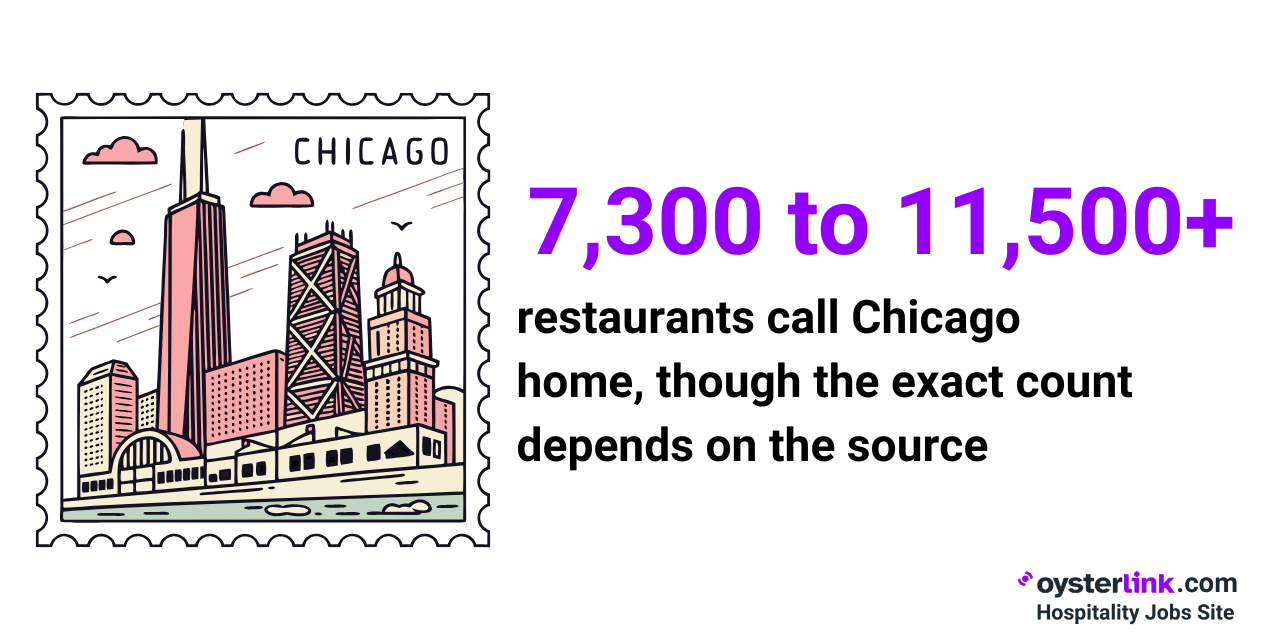Restaurants in Chicago are more than just places to eat - they're a bold expression of the city's soul.
This article serves up a fresh look at the scope, scale and heartbeat of one of America’s most exciting culinary capitals.
Total Number of Restaurants in Chicago
Estimates suggest Chicago has 7,300 to over 11,500 restaurants, based on different data sources.

The City officially reports 7,300 licensed establishments, while private data lists 11,524, and TripAdvisor shows around 9,600.
Here’s how different sources estimate the number of restaurants in Chicago:
| Source | Estimated number of restaurants | What’s included / notes |
|---|---|---|
| City of Chicago (licensed establishments) | 7,300 | Officially licensed venues listed by the city |
| Private business database | 11,524 | Includes a broader range of food businesses and venues |
| TripAdvisor | ~9,600 | Restaurants listed on the platform as of 2025 |
The exact count changes depending on whether food trucks, cafés, bars and ghost kitchens are included.
Restaurants in Chicago by Cuisine
Chicago’s food scene is as diverse as its people. There are about 3,736 American restaurants, 1,448 Mexican, 755 Italian and 409 Chinese spots.
These four cuisines alone account for thousands of restaurants across the city, with many more venues representing global cuisines like Indian, Middle Eastern, Japanese, Korean and others.
Types of Restaurants in Chicago
The city has an estimated 5,000+ full-service restaurants, alongside 4,000–5,000 fast-food and quick-service outlets.
Add to that hundreds of cafés and bakeries, 800–1,000 bars and taverns and 100–200 food trucks active in warmer months.
Here’s a quick table summarizing these figures for easy reference.
| Type of Restaurant | Estimated Count |
|---|---|
| Full-service restaurants | 5,000+ |
| Fast-food & quick-service outlets | 4,000–5,000 |
| Cafés & bakeries | Hundreds |
| Bars & taverns | 800–1,000 |
| Food trucks | 100–200 |
Restaurants in Chicago by Neighborhood
Most restaurants are concentrated in Chicago’s central and North Side neighborhoods.
Areas like The Loop, River North, West Loop, Lincoln Park and Lakeview each feature hundreds of eateries, offering everything from fast-casual spots to chef-driven dining.
.png)
South and West Side neighborhoods tend to have fewer restaurants overall but are home to many locally loved establishments and hidden gems.
| Neighborhood / Area | Restaurant Concentration | Notes |
|---|---|---|
| The Loop | Very high | Dense downtown area with many dining options |
| River North | Very high | Known for steakhouses, bars, and upscale dining |
| West Loop | High | Popular “Restaurant Row” with chef-driven spots |
| Lincoln Park | High | Mix of cafés, brunch places, and casual restaurants |
| Lakeview | High | Large variety of casual and mid-range eateries |
| South & West Sides | Moderate to lower | Fewer venues overall but strong local favorites |
These neighborhood categories reflect general trends rather than exact restaurant counts.
Top 10 Restaurants in Chicago
Chicago has an estimated 7,300 to 11,500+ restaurants, depending on how they are counted. From those thousands of options, here are 10 standout restaurants based on ratings, local reputation and consistent customer reviews:
1. Alinea
World-famous fine-dining experience with a creative tasting menu.
2. Girl & the Goat
Iconic West Loop spot known for bold, globally inspired dishes.
3. Lou Malnati’s Pizzeria
Classic deep-dish Chicago institution.
4. Smyth
Acclaimed tasting-menu restaurant rooted in Midwest ingredients.
5. Frontera Grill
Rick Bayless’s beloved modern Mexican restaurant.
6. Au Cheval
Known for serving one of Chicago’s most famous burgers.
7. Portillo’s
Legendary Chicago chain serving hot dogs and Italian beef.
8. The Purple Pig
Mediterranean-inspired plates on Michigan Avenue.
9. The Publican
A West Loop favorite known for farm-to-table dishes, charcuterie and seasonal American cooking.
10. Joe’s Seafood, Prime Steak & Stone Crab
Classic Chicago steak and seafood favorite.
The Big Picture: Restaurants in Chicago
Whether it’s Michelin-starred fine dining or late-night tacos from a food truck, Chicago’s thousands of food venues make it one of America’s culinary capitals.
The city’s restaurant count isn’t just about numbers — it’s about the culture, creativity and community they represent.










Loading comments...